Orphan
![]()
This article is about orphan - for other meanings, see Orphan (disambiguation).
Orphan (word restricted to the German and Dutch language area, mhd. weise, ahd. weiso, to wīsan, 'to avoid, abandon', always in the feminine) or orphan is a child who has lost one or both parents. Here a distinction is made between full orphans (where both parents have died) and half-orphans (where one parent has died). This child is called an orphan only if the loss of parents occurred during childhood or adolescence.
If a person loses his parents in adulthood, he is no longer called an orphan. Conversely, parents who have lost a child are called orphaned parents. Reasons that can lead to the orphaning of children include wars, disasters, accidents, terrorism or epidemics.
If, in the case of full orphans, no relatives (can) take care of the upbringing of the children, there are various other care options in Germany. In consultation with the Youth Welfare Office, the children are placed either with a foster family, in a children's home (formerly: orphanage or infant home) or, in the case of adolescents, in supervised youth living (sometimes called a youth home). Parents can determine in their wills to whom a child should go in the event of their untimely death. For this purpose, they appoint a guardian to take over the duties of parental care. The guardianship court is bound by the parents' decision as long as it is in the best interests of the child.
There is no globally binding and uniform regulation or definition on the subject of orphans. In the individual national states, legal or denominational regulations may differ from one another.
For example, in immigration in the United States, the Immigration and Nationality Act defines an orphan according to several criteria. Accordingly, a child may become an orphan through death, disappearance, failure to exercise parental care, separation, or loss of both parents. Further, a child is considered an orphan as long as the mother is unmarried and the natural father has not legitimized it. The child of a surviving parent may also be an orphan if the surviving parent has remained unmarried since the death of the other parent.
In Ukraine, the term orphan refers to, among other things, "children whose parents have died, or whose parents have been deprived of parental care, or who are serving a prison sentence in correctional institutions, or who have disappeared, or who have been declared physically or mentally incapacitated by competent bodies."
In Islamic law, sharia, minors who have lost their father are considered orphans, yatîm. The loss of the mother does not establish the status of an orphan. The background to this is the patriarchal concept of the family in Islam. Orphan status is also granted to foundlings, allaqît, or children born out of wedlock.
UNICEF and numerous international organizations (e.g. UNAIDS) revised the definition of orphans in the mid-1990s, when the AIDS pandemic led to the death of millions of parents worldwide and more and more children were growing up without one or more parents. The terminology single orphan - loss of one parent - and double orphan - loss of both parents - was introduced. Since then, UNICEF and global partners have defined an orphan as a child under the age of 18 who has lost one or both parents through death. Under this definition, there were nearly 140 million orphans worldwide in 2015 (according to UNICEF), including 61 million in Asia, 52 million in Africa, 10 million in Latin America and the Caribbean, and 7.3 million in Eastern Europe and Central Asia. Children who lost both parents were included, as well as children with one parent still alive. Of the nearly 140 million children classified as orphans, about 15.1 million have lost both parents. 95% of all orphans are over the age of five. This definition contrasts with orphan concepts in some developed countries, where a child must have lost both parents to be recognized as an orphan.
There is no reliable total number of all orphans worldwide. UNICEF gives an approximate figure of 163 million children who are considered orphans. Humanium (NGO) puts the number of orphans worldwide at 153 million, (of which 71 million are in Asia, 59 million in Africa and around 9 million in Latin America and the Caribbean). Every year in Germany, around 1,000 children and young people are registered for the first time as orphans by the German Pension Insurance. According to German pension insurance statistics, 303,920 people received half-orphan or full-orphan pensions in 2018. The average age of the recipients was 17.39 years. In Germany's statutory accident insurance system, the number of recipients of orphans' pensions had declined from nearly 35,000 in 1985 to about 9,000 in 2017. In Switzerland, the number of recipients of a simple orphan's pension (half-orphan's pension) declined from 61,406 to 41,856 between 1980 and 2000. In Russia, the number of orphans recorded by the Ministry of Education fell from 115,600 in 2008, to 47,800 in 2018. At the time, this was the lowest figure since the collapse of the Soviet Union.
Some of the best-known sponsors of children's homes in German-speaking countries are the organization SOS Children's Village, the German Red Cross, Diakonie, Pro Juventute and many other independent sponsors of public youth welfare.
In everyday life, the term orphan undergoes numerous linguistic adaptations: Euro-Orphans, EU Orphans, Orphans of Medicine (see Orphan Drugs, Rare Disease or Orphanet), Orphan Planet, Therapeutic Orphans, Orphans of Research, Orphans of Vision, Orphan Work or Orphan of Divorce.
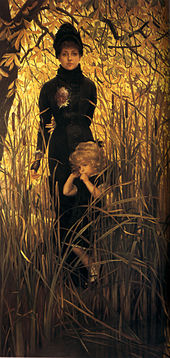
Orphan , James Tissot 1879
Social Orphan
A social orphan is a child who is not cared for by parents or relatives. Social orphanhood is a condition caused by non-performance of parental duties towards the minor child. Social orphans lose their parents as a result of various social, economic, moral and psychological causes and become orphans with biological parents who are still alive.
Conceptual classification
Nowadays, there are no established definitions and assessments of this category of children. Mass media, psychological and pedagogical works, as well as social surveys use the following terms: homeless children, non-supervised, street children, social orphans, underage risk groups, etc.
UNICEF counts the following groups as social orphans:
- Children who do not keep contact with their families and live in shelters;
- Children who keep contact with their families and live on the streets during the day and night because of poverty, exploitation and abuse in the family;
- Children who have grown up in homes, left them for many reasons and are living on the streets.
By raising awareness about the consequences of institutional care for social orphans in the first years of life (such as psychological hospitalism or deprivation), attempts were increasingly made from the 1970s (in Western countries) to improve the developmental chances of social orphans by taking them into foster families or SOS Children's Villages.
In professional discourses of pediatrics, social medicine, psychology, social work, and education, the effects of social orphanhood have received little or no attention since the 1990s.
Present
A dramatic increase in social orphans can be observed in many countries of the former Eastern bloc, especially after the political change. In 2012, UNICEF estimated the total number of street children in Ukraine alone at around 100,000. They are exposed to violence, sexual exploitation and HIV infections without protection. During interviews, many of these adolescents reported having to engage in prostitution. About 100,000 girls and boys live in institutions. Most of these children are social orphans. This means that parents abandon their children to a home out of need or hopelessness.
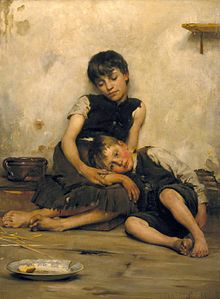
Orphans , Thomas Kennington 1885
AIDS Orphan
AIDS orphans are those children who have lost their parents due to the HI virus and occur primarily in African countries such as South Africa or Zimbabwe. Approximately 70,000 children are orphaned by AIDS each year. As a percentage of the total population, the Kingdom of Swaziland (now the Kingdom of Eswatini) had the highest proportion of people infected with AIDS in the world in 2014, at 27.7%. In 2008, 120,000 children in the kingdom were AIDS orphans, about 10% of the total population.
In 2004, the number of AIDS orphans worldwide rose to 15 million. Many more children and adolescents live with sick or dying parents, are marginalized, and are in turn more susceptible to infection with the AIDS virus, according to the United Nations report, "Children on the Edge of the Abyss," presented at the World AIDS Conference in Bangkok.
The number of AIDS orphans in Africa continues to rise - even in countries where the immunodeficiency is now being successfully combated. By 2010, 15.7 million are expected to have lost their mother, father or both parents on the continent. Often, the children have to care for their sick parents alone until they die. Worldwide, most AIDS orphans live in Asia, although the number of known cases has been declining since 1990, followed by Africa and Latin America.

AIDS orphans in South Africa, photo by Paul Weinberg 2004
War orphan
A war orphan is a child of a soldier killed in war. In a broader sense, children who have lost one or both parents to acts of war are also considered war orphans.
Germany
After World War II, tens of thousands of children were on the road alone - they were traumatized, starved and often seriously ill. Many of these war orphans arrived in Mecklenburg-Vorpommern, an important transit point for refugees from the eastern territories. In 1945 alone, 30,000 parentless refugee and displaced children were registered there. The flow of war orphans did not end in the years after the war: on a single day in May 1947, 3,000 children from East Prussia arrived in Pasewalk in Western Pomerania.
Thousands of German war orphans were on the move between East Prussia and the Baltic States after World War II. Many, who later lived as adults in Poland, Lithuania, Latvia or Estonia, assumed a false identity - they were given the name Wolfskinder.
Surviving Jewish orphans from concentration camps were grouped together in kibbutzim by Zionist organizations, among others, and prepared for their future in Israel. Many of them tried to gain a foothold in classic immigration countries such as the USA, Australia or Canada. Canada, for example, took in over 1,000 Jewish orphans. Operation Shamrock to rescue war orphans was based, among other things, on an idea of the Society for the Rescue of German Children. Over a thousand children, most of them from Germany, Austria and France, found refuge in Ireland from their countries devastated by World War II. The children, between the ages of 5 and 15, were to be "fostered" and stay for a few years at most. Some of them stayed forever.
At the end of World War II, there were about 500,000 war orphans and about 20 million half-orphans in Germany alone. Most of them had to live without a father.
England
Anna Freud and Dorothy Tiffany Burlingham, together with the pediatrician Josefine Stross, founded the Hampstead Nurseries, a home where they cared for war children and war orphans. In 1945 Anna Freud brought a small group of children from the liberated concentration camp Theresienstadt to London. They were cared for and looked after under her supervision (supervision). The memoirs of some of the children were published with their permission. Anna Freud herself wrote an article about them and published it in 1951 in the journal she founded.
Syria
Since the outbreak of the civil war in Syria in early 2011, there have been more than one million refugee children, according to the UN children's agency UNICEF. Many of the refugee children have been orphaned and traumatized by witnessing family members being killed. They have also been or are - according to these data - victims of sexual violence, torture and arbitrary detention, and have often been recruited as child soldiers.
Indochina
In the Indochina War, approximately 35,000 Germans, mostly (half-)orphans of the World War or former members of the Wehrmacht or SS, fought as Foreign Legionnaires on the side of the French. This corresponds to about two-thirds of all foreign legionnaires deployed. For some former Verding children and orphans from Switzerland, service in the French Foreign Legion was an option to escape the oppressive society and the wounds and scars inflicted in childhood.

Fountain of the Norns in St. Stephen's Green, Dublin, fountain donation by the FRG as a thank-you gift
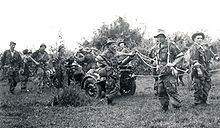
Foreign Legionnaires in the Indochina War 1953/1954

Woman with orphan boy , Berlin 1945
Orphan among indigenous tribes or peoples.
Among the Aché, an indigenous group living in eastern Paraguay whose way of life places them among the hunter-gatherers, killings between the different groups within the tribe and also within their families are not uncommon. If a member falls victim to the respective group, he or she is killed. Children and babies are also slain in the process. Thus, it is the custom to kill children whose parents have died, so that there are no orphans.
The Zuruahã live as a people in the Amazon region in Brazil. They gained notoriety for their widespread tendency to commit suicide by taking the drugs Kumady or Cunahá. As a result, the Indians become widows, widowers or orphans at an early age. Suicide is a natural part of their culture, although they have no word for it in their language.
Changes due to colonization and climate change have led to cultural change among the Inuit in Greenland. Among other things, this has an impact on the current social life in families as well as communities and sometimes leads to the uprooting of children. In the world's northernmost children's home, on the island of Uummannaq, orphaned and abused Inuit children learn to forget traumatic childhood experiences and gain the courage to build a new life with the help of educational approaches, unspoiled nature and a return to old traditions.
In Australia, in all states except Victoria, Aboriginal children were often taken away until 1972 to be raised as orphans away from their culture in reformatories or in the private homes of whites. It was only after the election of Gough Whitlams as premier that this practice, now known as stolen generations, was ended.
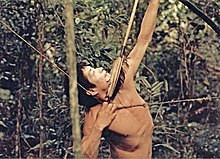
An Aché during the hunt
Effects due to orphaning
Traumas
With the help of the study Sequential Traumatization in Children, initially on the basis of around 2,000 and later on 204 more Jewish orphans interviewed in the Netherlands after the Second World War, the psychoanalyst Hans Keilson developed his findings and reflections on the long-term effects of trauma. The study contributed significantly to the view that trauma is no longer a unique, temporary event, but rather a lifelong process that spans generations. This process evolves in response to external events (e.g., cultural, social, or political) and often results in permanent or progressive vulnerability.
Sociological consequences
Those who lose their mother or father have - statistically speaking - fewer chances of higher education or qualified training. This is shown by a study from the Max Planck Institute for Human Development in Berlin. Even if only one parent dies, this has drastic consequences for the children. In addition to mourning the loss, the children have to cope with the fact that they can expect less support for their educational careers in the course of their education - emotionally and cognitively as well as socially and financially.
Steffen Hillmert of the Max Planck Institute for Human Development studied the educational trajectories of half-orphans born between 1950 and 1978 and compared them with those of people who were able to grow up in complete families until they reached adulthood. Children who lost a parent before the age of ten had worse chances of reaching high school than children who were orphaned a few years later. For both groups (orphaned before/after age 10), high school graduation rates were significantly reduced compared to children from complete families.
If the parent did not die until after the age of ten, most children remained in high school - despite the special burdens. The early death of a parent reduces the child's chance of graduating from high school by almost two-thirds. This means that if ten children in a comparable social group of children from complete families graduate from high school, only three to four children in an equally large group of orphans do so.
Orphans have the aura of misfortune, so many people feel deep compassion for orphaned and abandoned children and a desire to do something for them. Nevertheless, societal perceptions and stereotypes that orphans will not make it and will not manage their lives have a fatal effect on society's overall responsibility for them. This can take extreme forms, as in Nepal, where children are sometimes blamed for the death of their parents, or less conspicuous ones, as in the basic attitude that the state must take care.
Lack of attention, inadequate care, ignorance and discrimination can dramatically intensify the trauma of orphans and ultimately ensure that they really do not make it.
Psychosocial consequences
The psychosocial consequences of a child growing up without one of its parents are assessed differently and are also strongly dependent on other factors. The concrete impact of fatherlessness or motherlessness depends on a child's general psychological stability and the wider environment of fixed attachment figures. The personality of the parent also plays a central role. Fatherlessness is considered a problem for the development of gender identity.
Orphans in institutions (foundling homes, orphanages, infant homes) suffer the consequences of hospitalism and psychological deprivation.
A 2011 study in France examined the educational, social, occupational and emotional situation of 500,000 orphans under the age of 21. The study made clear how many orphans actually suffer from trauma and sociopsychological disorders. Years later, for example, only 50% of them could talk easily about what had happened; 18% could find no words at all. 76% felt that the loss of one or both parents had affected family relationships, 63% spoke of negative consequences for their emotional life, 52% saw their school career and 45% their social network affected. Orphans are less likely to reach out to those around them, withdraw or switch to defensive mode.
If a parent dies, the child's risk of suicide increases significantly. This is confirmed by a study conducted by Danish researcher Dr. Mai-Britt Guldin. A total of 7.3 million people from Denmark, Sweden and Finland were included in the data. Children and adolescents who lost a parent before reaching the age of 18 were considered. For comparison, they drew on a control group of children whose parents had not yet died. The researchers found that losing a parent during childhood increased the child's risk of committing suicide. This effect lasted up to 25 years after the parent's death. Another observation was that boys were twice as likely to commit suicide as girls. Boys whose mothers had committed suicide were most likely to be affected, as were firstborns in whom one parent had died before the child reached the age of six.
Prominent examples include Heinrich von Kleist, German playwright, storyteller, lyricist and publicist, and the German poet and romanticist Karoline von Günderrode. Kleist became an orphan at the age of 15, having lost his father earlier when he was ten. On November 21, 1811, Kleist chose to commit suicide at Stolper Loch, now Kleiner Wannsee. Günderrode became half-orphaned by the death of her father at age 6 and was later described by German writer Wolfgang Koeppen as the "orphan of Romanticism."
Psychosomatic consequences
Late adopted orphans who remained in the orphanage for eight months or longer show disorganized attachment behavior as four-year-olds. In the stranger situation, significantly higher salivary cortisol levels can be detected in these children.
Orphans remained comparatively cool despite closeness, their oxytocin levels low. Seth Pollack of the University of Wisconsin studied four-year-olds who were separated from their mothers immediately after birth and lived in a Russian or Romanian orphanage with those who grew up with their parents. It was found that in the biological children there was a sharp increase in oxytocin, a hormone known as the bonding hormone, a guarantor of pleasant feelings.
Somatic consequences
In a study, scientists led by Stacy Drury of Tulane University in New Orleans examined the genetic material of 109 neglected Romanian orphanage children. The analyses revealed that the children, who had been in the homes for at least five years, had significantly shorter telomeres than would have been appropriate for their age. This is a sign of premature aging of the genome. This effect was more pronounced in the girls than in the boys.

Max Planck Institute for Human Development in Berlin-Wilmersdorf
_in_Dallas_-_(2).jpg)
Suicide jumper - Dallas
Orphan in the religions
Judaism
According to biblical tradition, the prophet and orphan Moses led the people of Israel on a forty-year migration from Egyptian slavery to the Canaanite land.
In Judaism, caring for orphans is seen as a social and moral imperative to do justice and love, i.e., to live a life filled with meaning (Psalm 146:9). The Torah warns against oppressing orphans several times (Exodus 22:20-23; 23:6, 9; Zechariah 7:9-10; ). To clothe, feed, and love them is commanded separately (Deut. 10:19). To give them freewill offerings at the Feast of Weeks is commanded (Dt 14:29, 16:10-12). The right of orphans is not to be bowed down (Dt 24:17, 27:19), rather good and justice are to be done to them, righteousness established (Isaiah 1:17). The harvest tax of the tithe is to flow every three years to the strangers, the widows and orphans in the land (Dt 14:28 f). God's moral commandment to love one's neighbor, which includes all people, even the enemy, is concretized in terms of those in need of help and orphans (Isaiah 1:16-17; Job 31:13-25,29-30,32-33,38-39; Amos 5:14-15; Jeremiah 7:5-7; Malachi 3:5; Maimonides, Mishneh Torah Hilchot Yom Tov 7:18-21).
The Aramaic Kaddish of the Orphans (Kaddish jatom) is a prayer in Judaism. It is a sanctification prayer and formed its current fixed form in the centuries after the invention of printing. In the process, its traditional core expanded and its liturgical use changed over the centuries in the Diaspora. The Kaddish of the Orphans is also called the "Kaddish of the Sufferers" (Awelim Kaddish). Those who say the kaddish - first at the funeral of one of the "seven close relatives" (father, mother, brother, sister, son, daughter or wife) - repeat it during the eleven months following the person's death.
The Talmud says, "God says to man, you have four households, the son, the daughter, the maid; I also have four households, the Levite, the stranger, the widow and the orphan."
Christianity
Christianity does not provide a commandment for orphans. Charity commands the support of orphans. Thus, James 1:27 states, "A pure and blameless service before God the Father is to care for orphans and widows when they are in need, and to keep oneself from being defiled by the world."
On September 27 of each year, the Catholic Church celebrates the feast of Mary, Patroness of Orphans. In 1928, Pope Pius XI declared the founder of the Somasker order Hieronymus Ämiliani the patron saint of orphans and abandoned youth. In addition, St. Ivo Hélory of Kermartin and St. Vincent de Paul, among others, are listed as patrons of orphans.
The main ideas of the Jewish prayer Kaddish of the Orphans were incorporated into the Lord's Prayer, the most widespread prayer in Christianity and the only one that, according to the New Testament, Jesus Christ himself taught his disciples.
Among the four (since 1997 in the Catechism of the Catholic Church five) flagrant sins counted in Christian theology is the oppression of the poor, widows and orphans.
The Shakers are a Christian free church in the USA, which emerged from Quakerism. The members of the congregation were characterized on the one hand by a high work ethic and on the other hand by an almost monastic, celibate life. Shaker communities reached their greatest expansion in the mid-19th century, with about 20 settlements and 6,000 members. New members came into the community through entering adults as well as adopted orphans or surrendered foundlings. With the spread of state orphan care, the communities lost much of their potential new blood. In 2017, there were still two active members.
· 
"The Eternal protects the stranger [gerim], orphans and widows He strengthens" (Psalm 146:9) Sephardic Torah reading in prayer, Porat, Israel (ca. 1949-1951).
·
Jerome Amiliani with crucifix and halo, Catholic patron saint of orphans
· 
Sura 4 an-Nisā'; Mohammed himself was an orphan
· 
Siddhartha Gautama (Buddha)
Islam
In Islam, an orphan is a child who has not reached religious maturity and has already lost one or both parents. In order to improve the situation of orphans in ancient Arab society, the relatives or the community should take care of their welfare. Numerous verses in the Quran refer to this directly or indirectly. The reception and care of orphans is legally regulated under the term "kafala." According to a ruling by the European Court of Human Rights, it does not constitute a legal relationship of kinship and is more akin to a relationship of guardianship.
The Quran contains several instructions regarding orphans at the beginning of Sura 4. For example, believers are instructed not to touch the property of orphans (Sura 4:2), and they are encouraged to marry orphans to ensure their provision (Sura 4:3). At the same time, it is the basis for limiting plural marriage to four wives. It says, "And if you fear not to act justly with regard to orphans, then marry what seems good to you in wives, two, three, or four. But if you fear not to act justly, then (only) one or what your right hand possesses. That is more likely that you will not be unjust. He who consumes the wealth of orphans unjustly shall one day have nothing but fire to eat and shall burn in a hell fire (Sura 4:10). In total, the word orphan is mentioned 23 times in the Quran. Orphans are mentioned as recipients of war booty. The biography of Muhammad, the founder of the religion, Sîra, mentions that he became an orphan at the age of 5. Orphaned is also Ahmad at-Tijānī, founding father of the Tijani order, a moderate-orthodox Sufi brotherhood (tariqa) within Sunni Islam.
According to the interpretation and interpretation of Sura 93 verses 6-8, we, the believers, are all orphans in our relationship with God and in need of guidance.
Buddhism
The world's fourth largest religion, Buddhism was founded in northern India by Siddhartha Gautama (Buddha), who lost his mother shortly after his birth. At the age of 29, he realized that sufferings such as aging, illness, death or pain were inseparable from life. He set out to explore various religious teachings and philosophies to find the true nature of human happiness. Six years of asceticism and meditation finally led him to the path of the middle. Under a poplar fig in Bodhgaya, he had the experience of awakening (bodhi). A short time later, he gave his first teaching talk in Isipatana, today's Sarnath, and thus set the "wheel of teaching" (Dharmachakra) in motion.
The founder of Buddhism in Tibet, Padmasambhava, came into the world during the time of King Thrisong Detsen (756 to 796). He grew up as a foster son of King Indrabhuti in what is now Pakistan. According to legend, he was not born of a woman, but was miraculously born on a lotus in a lake in Oddiyana.
Foundlings and orphans were taken into temples, as in China by the scholar and writer Lu Yu, or raised and trained as Buddhist monks, as in Korea during the Goryeo dynasty.

Shaker dance
Orphan in mythology
Greek mythology
Charila (ancient Greek Χάριλα) is the name of an orphan girl in Greek mythology, as well as the name of a festival celebrated every eight years in Delphi, which was named after her. About the origin of the festival Plutarch tells that at a time when there was hunger, the people came to the king to ask him for food. The king distributed flour and legumes - to the better citizens. When a poor orphan girl named Charila persisted in asking the king for food, the angry king hit the girl in the face with his sandal, whereupon Charila went into the forest and hanged herself with her belt. Thereupon the famine became unbearable and the oracle was asked for advice. The oracle said that Charila should be reconciled. After some research, they found out who Charila was, and finally her body was found. To reconcile the spirit of Charila, the process was repeated.
Roman mythology
Romulus and Remus were the founders of Rome according to Roman mythology. According to the legend, they were children of the god of war Mars and the priestess Rhea Silvia. There are different versions of the legend concerning the abandonment and rescue of the children. After the murder of his brother, Romulus ruled over the city. His dead brother Remus was immortalized with his sword on his throne. According to Titus Livius, the city of Rome was founded on April 21, 753 BC.
Asmatian mythology
The mask festival of the Asmat, also Bi Pokomban, Yipai, is an animistic, cyclically celebrated ritual of the Asmat, a people living in the south of the Indonesian island of New Guinea in the province of Irian Jaya. The ritual aims to prove to the spirits of the deceased that harmony prevails in the village and that the ancestors (safan) may take note of this benevolently, so that their favor can be preserved.
The mask festival takes place according to a fixed schedule. The appearance of the Manimar mask has a mythological basis. The myth tells that a regularly outcast orphan boy, who was rarely heard begging for food, fell for the trick of creating a mask by means of which he would frighten the sago-harvesting women of the village in order to take away their harvest. He often succeeded in this. Caught in the act and confronted, the boy lamented his suffering and was adopted and cared for out of pity.
Manimar has since been part of the ritual myth of the Feast of the Mask. He is revered as the forerunner and bearer of the news of the arrival of the spirits. His arrival arouses the gathered people. Staggering and dancing, he joins the people. In the ritual act, he frightens people (especially children), whom he chases. The children fight back and demand that he leave the village, since he is an intruder and also an orphan. They throw seed pods at him and scold him. Again and again the Manimar pursues in return single persons. whom he has chosen for a pursuit. In the course of the afternoon he disappears again.
Inuit mythology
In the Inuit myth Kaassassuk, the story is told of the deprived life of the scorned and oppressed orphan Kaassassuk: The overcoming of his fear and the bestowal of superhuman powers by the spirit being Pissaap Inua; Kaassassuk's impressive deeds that instill respect and fear in the community; his revenge on the inhabitants of the settlement; his journey by kayak down the coast, during which he forcibly takes the daughter of the hunter Qaassuk as his wife; his victorious contests with all the men he encounters, and finally his defeat by the unassuming Usugsaermiarssúnguaq high in the north. Today, the figure of Kaassassuk in Greenland is symbolic of physical and psychological strength and the will for self-determination.
Blackfoot mythology
A mythical tale of seven orphans reflects the experience of the joint emergence and disappearance of the constellation of the Pleiades and the bison for the Blackfoot Indians of North America. The position of the Pleiades at the beginning of the dry season was the starting signal for an elaborate drive hunt of the huge bison herds. If the Pleiades disappeared in the starry sky, the bison disappeared at the same time. According to legend, seven orphans who had once been denied warming bison pelts took the bison with them as punishment from humans. The sun god saved the children and gave them a place in the starry sky. Dogs pleaded for the villagers by howling at the night sky. Finally, the children returned with the bison.
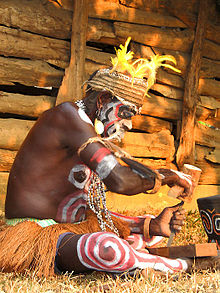
Orang Asmat
.JPG)
Capitoline she-wolf suckles children Romulus and Remus
Personalities with orphan background (selection)
Africa
· 
Hatshepsut
· _(11782160603).jpg)
Nefertiti
· 
Charlize Theron
· 
Mobutu
· .jpg)
Eusebio
· 
Ibn Khaldun
· 
Miriam Makeba
· .jpg)
Nelson Mandela
· .jpg)
Cesária Évora
· 
Jean-Bédel Bokassa
Asia
· 
Genghis Khan
·
Saddam Hussein
· 
Osama bin Laden
· 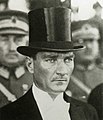
Mustafa Kemal Atatürk
· 
Preity Zinta
· 
Confucius
· 
Hu Jintao
· 
Garry Kasparov
· 
Mohandas Karamchand Gandhi
· 
Kawabata Yasunari
Australia and Oceania
· _p187_TASMANIA,_THE_LAST_OF_THE_ABORIGINALS_(LADY).jpg)
Truganini
· .jpg)
Cate Blanchett
· 
Pomaré IV.
· 
Jason Day
· 
Kamehameha III.
· .jpg)
Kiri Te Kanawa
· 
Guy Pearce
·
Thomas Bracken
· 
Kevin Rudd
· .jpg)
Te Rangi Hīroa
Europe
· 
Michelangelo (half-orphan at the age of 6)
· 
Isaac Newton (half-orphan at 3 months)
· 
Louis XIV (half-orphan at the age of 5)
· 
Johann Sebastian Bach (orphaned at the age of 8 or 9)
· 
Georg Philipp Telemann (half-orphan at the age of 4)
· 
Elizabeth I of England (orphaned at the age of 2 or 13)
· 
Augustus (half-orphan at the age of 4 or 5)
· 
Napoleon Bonaparte (half-orphan at the age of 15)
· 
The Brontë siblings (half-orphans from 1 to 5 years old)
· 
Charles Darwin (half-orphan at the age of 8)
· 
Queen Victoria (half orphan at 8 months)
· 
Marie Curie (half-orphan at the age of 10)
· 
Adolf Hitler (half-orphan at the age of 14)
· .jpg)
Christine Lagarde (half-orphan at 17)
· 
Prince Harry (half-orphan at the age of 12)
· 
Coco Chanel (half-orphan at the age of 12)
· 
John Paul II. (half-orphan at the age of 8)
· 
Valentina Vladimirovna Tereshkova (half-orphan at the age of 2)
· .jpg)
Ulrike Meinhof (orphaned at the age of 15)
· 
Virginia Woolf (half-orphan at age 13)
North America
· 
Red Cloud
· 
Leonard Cohen
· 
James Dean
· 
Marilyn Monroe
· 
Barbra Streisand
· .jpg)
Julia Roberts
· 
Malcolm X
· 
Tina Turner
· 
Jacques Villeneuve
· 
George Washington
South America
· 
Tupac Amaru II.
· 
Simón Bolívar
· 
Paulo Freire
· 
Eva Perón
· 
Peter II. (Brazil)
· 
Victor Jara
· 
Gustavo Kuerten
· 
João Havelange
· 
Ivian Sarcos
· 
Pablo Neruda
See also
- Permanent homes for infants and very young children in the GDR
- Ward
- Orphan's pension
Search within the encyclopedia


